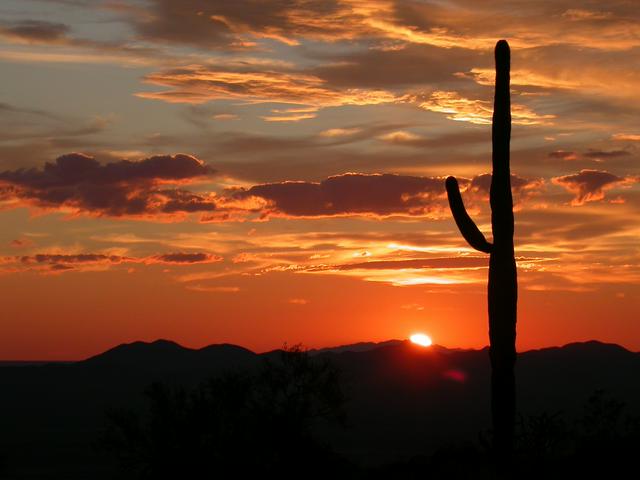
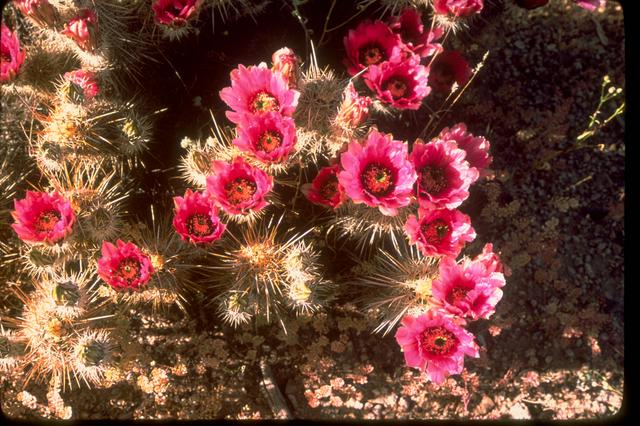
Saguaro National Park is a United States National Park that is near Tucson, Arizona. There are two regions of the park: Saguaro East lies 20 miles east of Tucson, and Saguaro West is 15 miles west of the city center.
Saguaro National Park protects two areas of the Sonoran Desert near Tucson. While both Saguaro East and Saguaro West contain high densities of saguaro cacti, the park is also home for many other desert species.
Saguaro National Monument was created in 1933 by President Herbert Hoover, and became the 52nd national park in 1994. Then, Saguaro National Monument consisted only of what is today Saguaro East (the Rincon Mountain District). The 15,364 acres of Saguaro West (the Tucson Mountain District) were added in 1964 by President John F. Kennedy, and 21,000 acres were added later.
The park is in the Sonoran Desert, a dry and hilly area that includes the Tucson Mountains and the Rincon Mountains.
The park's namesake, the massive saguaro can live as long as 200 years, growing over tall and weighing more than 10 tons (9000 kg). The saguaro has become an icon of the desert, with its distinctive tall trunk and numerous curved arms that branch upward. The saguaro survives in the hot, dry desert through a series of adaptations, including a folded skin that can expand or contract depending on the amount of water collected. In addition, the lack of leaves and the plant's waxy skin reduces evaporation losses. Unlike most plants cacti perform photosynthesis in their trunk. The saguaro's root system usually lies within three inches of the ground surface and spreads out in a circle roughly as wide as the plant's height, allowing the cactus to collect any rainwater that may fall nearby.
Other species of cactus in the park include the wide barrel cactus, the spiny fishhook and cholla cacti, and the oddly-constructed prickly pear cactus. Various bushes, including creosote and mesquite, as well as numerous desert wildflowers, fill the desert with flowers after rains.
Most animals in the desert are difficult to spot due to their nocturnal habits or camouflage, but keen-eyed visitors might find quail, roadrunners, woodpeckers, flickers, wrens, owls, hawks, desert tortoise, gila monsters, javelinas (wild pigs), kangaroo rats, coyotes, foxes, and jackrabbits.
High temperatures during the summer frequently rise above, and an average of less than twelve inches of rain falls in the park each year. Summer low temperatures average. During the winter, the high temperature averages, with nighttime lows around .
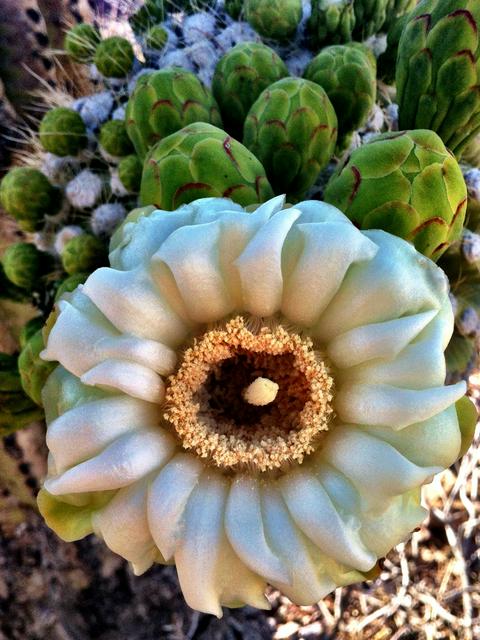 All private vehicles entering Saguaro National Park must pay a $10 entrance fee that is valid for seven days. Individuals on foot or bicycle must pay a $5 entrance fee, also valid for seven days.
All private vehicles entering Saguaro National Park must pay a $10 entrance fee that is valid for seven days. Individuals on foot or bicycle must pay a $5 entrance fee, also valid for seven days.
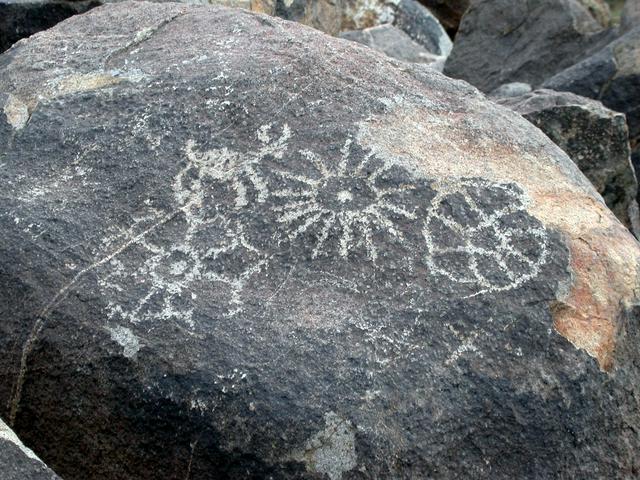
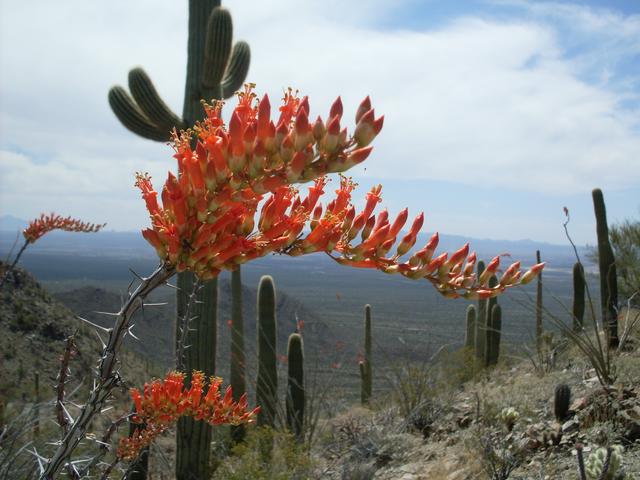
- Rincon Mountain Visitor Center, Cactus Forest Dr, +1 520-733-5158. Daily 9AM-5PM, closed Dec 25. The visitor center provides park information, a 15-minute orientation film, and exhibits on the natural and cultural history of the Sonoran Desert.
- Tucson Mountain Visitor Center, 2700 N Kinney Rd, +1 520-733-5158. Daily 9AM-5PM, closed Dec 25. Like the Rincon Mountain Visitor Center, this visitor center provides park information, a 15-minute orientation film, and exhibits on the natural and cultural history of the Sonoran Desert.
Rincon Mountain Visitor Center, Cactus Forest Dr, +1 520-733-5158. Daily 9AM-5PM, closed Dec 25. The visitor center provides park information, a 15-minute orientation film, and exhibits on the natural and cultural history of the Sonoran Desert.
Tucson Mountain Visitor Center, 2700 N Kinney Rd, +1 520-733-5158. Daily 9AM-5PM, closed Dec 25. Like the Rincon Mountain Visitor Center, this visitor center provides park information, a 15-minute orientation film, and exhibits on the natural and cultural history of the Sonoran Desert.
- Scenic Drives. In West Saguaro, the six-mile Bajada Loop Drive (unpaved) leads through a large saguaro forest. In East Saguaro, the eight-mile Cactus Forest Drive (paved) also passes through a dense saguaro forest.
- Hiking. There are over 150 miles of trails in the park's two districts.
- Hugh Norris Trail. An round-trip that leads to the summit of Wasson Peak, gaining over of elevation in the process. This trail passes through some beautiful desert landscape and provides excellent views.
- Tanque Verde Ridge Trail. This trail provides access to the backcountry areas of Saguaro East. It is a strenuous, multi-day trek that passes by the 7,049 foot Tanque Verde peak. Inquire at the visitor center for more information.
- Photography. The park provides exceptional sunrise and sunset photography. Flowers and cacti bloom throughout the year, with the saguaros sprouting large white flowers during May and June.
Scenic Drives. In West Saguaro, the six-mile Bajada Loop Drive (unpaved) leads through a large saguaro forest. In East Saguaro, the eight-mile Cactus Forest Drive (paved) also passes through a dense saguaro forest.
Hiking. There are over 150 miles of trails in the park's two districts.
- Hugh Norris Trail. An round-trip that leads to the summit of Wasson Peak, gaining over of elevation in the process. This trail passes through some beautiful desert landscape and provides excellent views.
- Tanque Verde Ridge Trail. This trail provides access to the backcountry areas of Saguaro East. It is a strenuous, multi-day trek that passes by the 7,049 foot Tanque Verde peak. Inquire at the visitor center for more information.
Hiking. There are over 150 miles of trails in the park's two districts.
- Hugh Norris Trail. An round-trip that leads to the summit of Wasson Peak, gaining over of elevation in the process. This trail passes through some beautiful desert landscape and provides excellent views.
- Tanque Verde Ridge Trail. This trail provides access to the backcountry areas of Saguaro East. It is a strenuous, multi-day trek that passes by the 7,049 foot Tanque Verde peak. Inquire at the visitor center for more information.
Photography. The park provides exceptional sunrise and sunset photography. Flowers and cacti bloom throughout the year, with the saguaros sprouting large white flowers during May and June.
Both visitor centers have bookstores which feature material of local interest.
There is no place within the park to purchase food, although there are numerous roadside picnic areas. An abundance of restaurants and grocery stores are within a short drive from the park boundaries and in Tucson.
While not known for its bar scene or wild nightlife, the wily traveller may nevertheless be able to purchase bottled water at a visitor center. Budget travellers may be more interested in the free water dispensed from the fountains at either visitor center. Aside from the visitor centers, water is not generally available in the park. For anything stronger, a visit to the business establishments outside of the park will be required.
The greatest danger in the park is the heat. Plan on drinking at least one gallon (3.8 L) of water per day, and never hike without carrying water. When hiking, drink frequently even if you do not feel thirsty as the onset of thirst in the desert is often the first sign of dehydration. During storms flash floods can pose serious hazards, and it is advisable to stay out of washes and canyons.
Additional dangers exist from the flora and fauna within the park. Stepping on or touching a cactus spine can be a painful experience; staying on the trails minimizes the chances of an unwanted cactus encounter. Rattlesnakes and gila monsters are poisonous, but in general neither will bite unless surprised or threatened. Scorpion stings are painful but not fatal, and can be easily avoided by not reaching under rocks. Javelinas may be dangerous if cornered.
- Tucson
